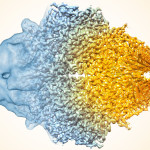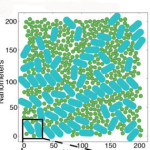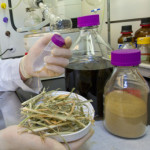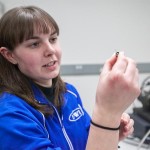The Biosciences Area launched a new Twitter account today. The social media platform will serve as a support tool to the Biosciences Area’s broader communications strategy. Expect to see news and latest achievements from the Area’s Divisions and User Facility: Biological Systems and Engineering, Environmental Genomics and Systems Biology, Molecular Biophysics and Integrated Bioimaging, and DOE’s Joint Genome Institute. Follow @LBNLBioSci.
Got It Down Cold: Cryo-Electron Microscopy Named Method of the Year
In his blog late last week, NIH Director Francis S. Collins highlighted Cryo-EM Microscopy, the Method of the Year 2015. Collins gave a retrospective analysis of how far the method has come over the past decade, and credits most of the advances to improvements in the technology available, particularly computational methods for image construction and direct electron detectors that can fix the blurring problem caused by molecules moving around in the electron beam. With these and other changes, the number of structures determined using this method have increased substantially in just the past year. Molecular Biophysics & Integrated Bioimaging’s Robert Glaeser got a shout-out for his Nature Methods commentary, which says that owing to the laws of physics, we can expect more good things.
Seeing the Big Picture in Photosynthetic Light Harvesting
Graham Fleming, chemist senior faculty scientist in Molecular Biophysics & Integrated Bioimaging, led the creation of the first computational model that simulates the light-harvesting activity of the thousands of antenna proteins that would be interacting in the chloroplast of an actual leaf. The results from this model point the way to improving the yields of food and fuel crops, and developing artificial photosynthesis technologies. Read more at Berkeley Lab News Center.
JBEI Researchers Develop First High-Gravity One-Pot Process for Producing Cellulosic Ethanol
JBEI researchers Seema Singh and Blake Simmons of the Biological Systems and Engineering Division led the development of a “high-gravity” one-pot process for producing ethanol from cellulosic biomass that gives unprecedented yields while minimizing water use and waste disposal. “High gravity” means high biomass loading – the higher the biomass loading, the lower the costs for converting it to fuels. Read more at Berkeley Lab News Center.
JBEI and GLBRC work together to break down lignin and advance biofuels
To tackle what many consider the next frontier in biofuels research Joint BioEnergy Institute (JBEI) and Great Lakes Bioenergy Research Center (GLBRC) recently joined forces. The focus of their collaboration? Lignin, a glue-like compound in the cell wall of most living plants that gives them their sturdiness.
With two new studies already complete, the two Department of Energy’s Bioenergy Research Centers are finding ways to convert lignin from an undesirable byproduct into a starting material for advanced biofuels and other lucrative chemicals. Read more at the GLBRC website.
- « Previous Page
- 1
- …
- 199
- 200
- 201
- 202
- 203
- …
- 213
- Next Page »
Was this page useful?








